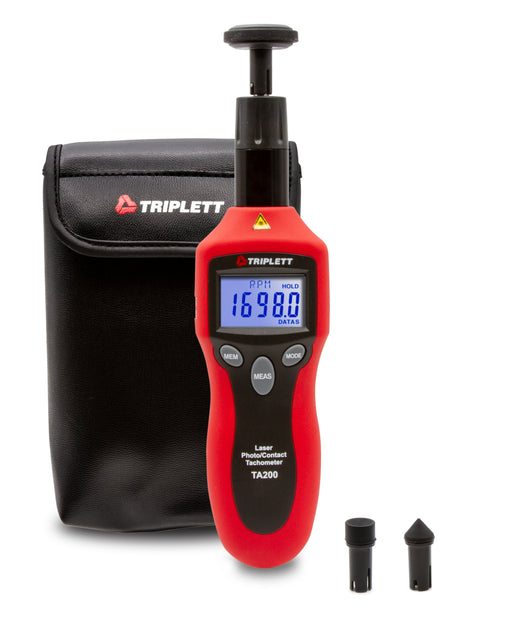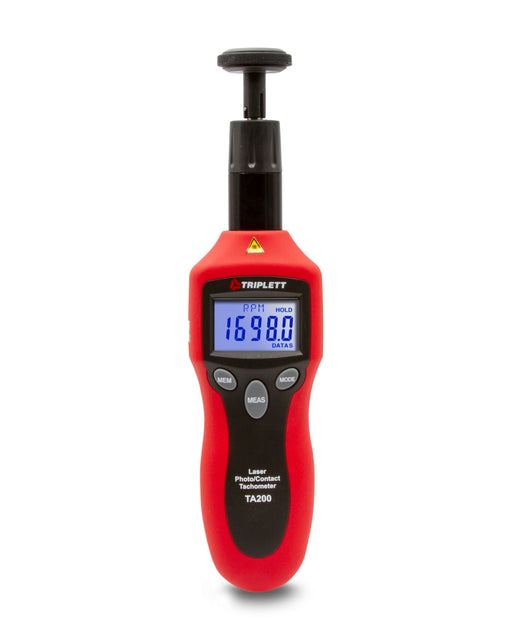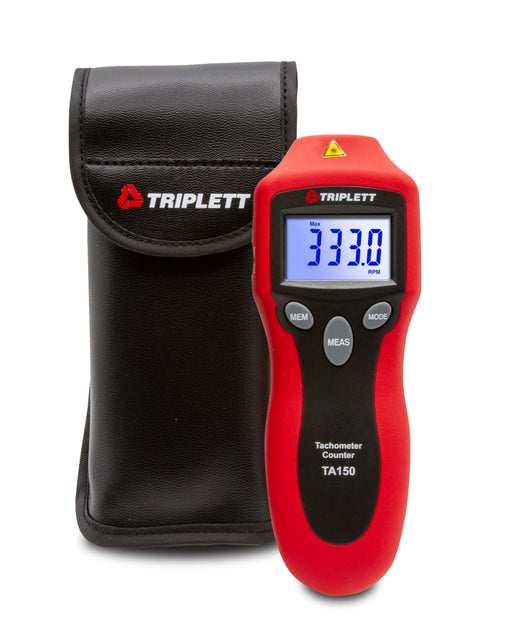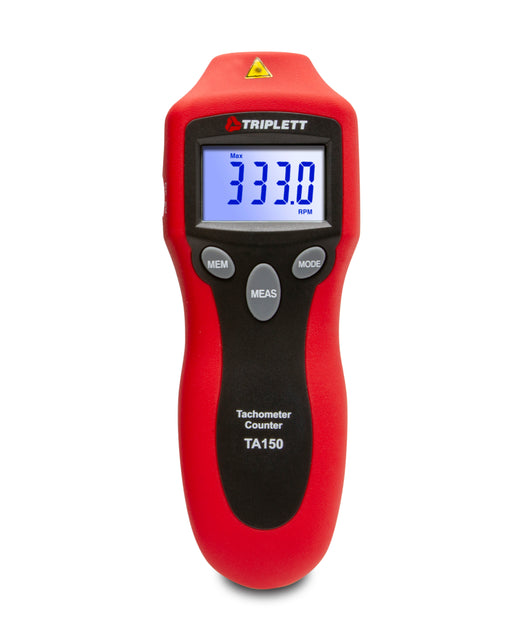Know More About Triplett Tachometers
What is a photo tachometer?
A tachometer, also known as revolution counter, is an important equipment in industrial settings for measuring the rotational speed of a motor or machine. It accurately records revolutions per minute (RPM), ensuring the machinery operates within optimal speed ranges. Tachometers are crucial for monitoring and maintaining the efficacy of engines, motors, and other rotational systems which prevents from over-speeding and mechanical failures. The RPM tester or RPM gauge may be a non-contact RPM meter with a sensor such as digital industrial tachometers and laser RPM meters or a contact RPM meter.
Photo tachometers are portable, handheld devices, which use non-contact method of RPM measurement. These devices ensure the conversion of RPM into electrical pulses, which can be easily measured. We provide photo tachometers designed to assure fast and accurate non-contact rotational speed (RPM) and total revolutions (REV) measurements. Laser RPM tachometers are a type of photo tachometer.
Photo tachometers are commonly used to measure the rotational speed of motors, engines, fans, conveyors, and other rotating machinery. By accurately measuring RPM, they help in ensuring proper equipment operation, identifying abnormalities, and maintaining optimal performance.
What are laser tachometers?
Laser tachometers, also known as laser photo tachometers or laser digital tachometers features a laser on the end of the device, which is usually focused on the rotating object to measure its RPM. Laser tachometers are non-contact type tachometers, usually preferred in hard-to-access areas such as confined spaces, engines of industrial machinery, and so on. Laser tachometers can be used for various distances, depending on your model. The Triplett TA200 tachometer and TA150 Tachometer are both laser RPM tachometers, which assure accurate long distance measurements. The Triplett Model TA150 Tachometer can be used to measure RPM for a 1.6 ft (500mm) maximum target distance. However, the Triplett TA200 tachometer is designed for laser-guided non-contact measurement with 8.2ft (2500mm) maximum target distance.
What are the types of digital tachometers?
Digital tachometers are distinguished into two types – contact and non-contact types.
- Non-contact Tachometer: The non-contact types feature a light source, which produces a focused beam and bounces off reflective surfaces. Whenever a component or part rotates, the light from the reflector hits the sensor located in the tachometer. The tachometer counts each time the light hits the sensor in a given timeframe. This result is then expressed in revolutions per minute.
- Contact Tachometers: These tachometers feature a free spinning wheel that comes in contact with the rotating surface. The wheel is propelled by the surface, and this produces pulses. These pulses are interpreted by the tachometer as RPM. Many contact tachometers are also used to measure linear speed and distance. The Triplett TA200 Tachometer is a type of contact tachometer used for a wide range of linear surface speed measurements such as meters per minute, feet per minute, inches per minute, and yards per minute. They can also be used to measure the length of products such as sheets and wires in meters, feet, inches, and yard.
Importance of RPM Measurement in Industrial Settings
RPM measurement is vital in industrial settings for ensuring optimal performance, safety, and longevity of machinery. Here are some pointers regarding the importance.
- Digital RPM meters are widely used to ensures all the motors, engines, and other rotating equipment operate within their designated speed limits
- This is crucial for safety as it helps prevent dangerous over-speeding and minimizes the risk of mechanical failures and accidents.
- It also boasts efficacy by ensuring machinery operates at optimal speeds, thus reducing operational costs, and aids in predictive maintenance by allowing early detection of issues before they lead to costly repairs or downtime.
- RPM measuring devices with advanced sensors such as industrial tachometers and laser RPM meters can and store accurate and real-time data on the rotational speed of various equipment, enabling operators to make informed decisions.
- We offer laser photo tachometers for accurate RPM measurement. They come with features such as quartz crystal time base, fast sampling rate, and backlit LCD display. They have built-in memory that can recall Min/Max/Last Value stored.
- Most models have a wide RPM range from 2 to 99,999RPM, which makes them compatible in many industrial settings.
Application of Using Laser Photo Tachometers as RPM Measurement Instruments
Non-contact meters such as laser photo tachometers, are essentially used for accurately measuring rotational speed in crucial industrial applications with tight tolerances. These advanced devices use a laser beam to reflect off a rotating object, allowing precise measurement without direct contact. At Triplett, we offer some of the best types of laser photo tachometers for fast and accurate non-contact RPM measurements of rotating objects, along with REV measurement counts. Most meters have a maximum target distance of around 19.7 inches (500mm), which allows for safe and convenient measurements.
Here are some key applications of our laser photo tachometers across industries.
- Monitoring and Maintenance: In industries such as manufacturing and automotive, laser photo tachometers are used to monitor the RPM of engines, motors, and other rotating machinery. This helps in predictive maintenance by detecting anomalies early, preventing costly breakdowns and downtime.
- Quality Control: Ensuring consistent rotational speeds is crucial in processes like assembly line production and material processing. Laser RPM meters provide real-time feedback, enabling adjustments to maintain product quality and uniformity.
- Research and Development: In R&D settings, precise RPM measurement is vital for testing new machinery and components. Here, these instruments deliver the accuracy needed to evaluate performance and durability under different operating conditions.
- Field Service: Technicians and engineers use these portable laser RPM gauges for on-site inspections and troubleshooting. The non-contact nature of these devices makes them ideal for measuring the RPM of equipment in hard-to-reach or hazardous areas without stopping the machinery.
- Energy Efficiency: By monitoring the RPM of fans, pumps, and other energy-intensive equipment, laser RPM Meters help optimize performance and reduce energy consumption. This contributes to cost savings and sustainable operations.
- Safety Compliance: Ensuring that machinery operates within safe RPM ranges is critical for occupational safety. Laser RPM measuring instruments provide the necessary data from their memory to comply with safety regulations and standards, preventing accidents and ensuring a safe working environment.
How to prepare a digital tachometer for measurements?
Follow the below-given steps to prepare contact and non-contact tachometers for measurements.
Non-contact (Photo) Tachometers
- Apply a small piece of tape to the surface of the rotating object under test.
- Ensure to fix the tape closer to the outer edge of the object subjected to the test.
- If your device has a meter collar, then ensure to remove it.
- Start taking the measurements by pointing the tachometer onto the surface.
Contact Tachometers
- Avoid step 3 if you are taking contact measurements.
- Attach the meter collar if not already done.
- Slide the adapter of the contact device onto the shaft of the tachometer.
- Ensure to align the adaptor and the alignment pin on the contact adaptor.
- Next, attach the contact measurement accessory such as a wheel, cone, and concave accessory onto the contact adaptor.
- Use the contact meter to measure the surface length and surface speed.
Are there any considerations to make when taking non-contact (photo tachometer) measurements?
Yes, there are certain considerations to make while taking measurements using non-contact tachometers.
- The bright ambient light produced by the tachometer may interfere with a light beam that reflects from the operational surface. In this scenario, you must shade the target area. The non-reflective area must be kept larger than the reflective area.
- Most surfaces are reflective. You can cover it with paint or black tape before applying the reflective tape. If you are taking low RPM measurements, ensure to use additional squares of reflective tape. You can calculate the RPM by dividing the reading on the digital display by the squares of reflective tapes.
- Keep the tachometer closer to the rotating surface to derive accurate readings. Ensure to keep the tachometer at least 15cm from the surface.
- Avoid taking measurements with dim laser light. A bright laser helps in accurate speed measurement.
How to choose the right tachometer for your industrial applications?
There are certain things to keep in mind when choosing industrial tachometers for your applications. Our experts will help you with the right selection, however, the following pointers will be helpful in this context.
- Can you access the equipment under consideration?
- Is it safe to go near the equipment to make a direct contact?
- Do you want to measure other factors like RPM, linear distance, and surface speed using your tachometer?
Browse More Building, Maintenance & Environmental Collections
Inspection & Laser Distance Meters:
| Borescope Camera | Manometers | Laser Distance Meters |
Gas Meters:
| CO & CO2 Meters | Combustible Gas Detectors | Formaldahyde Meters |
Environmental Meters:
Water Quality:
| PH and Conductivity Meters |




